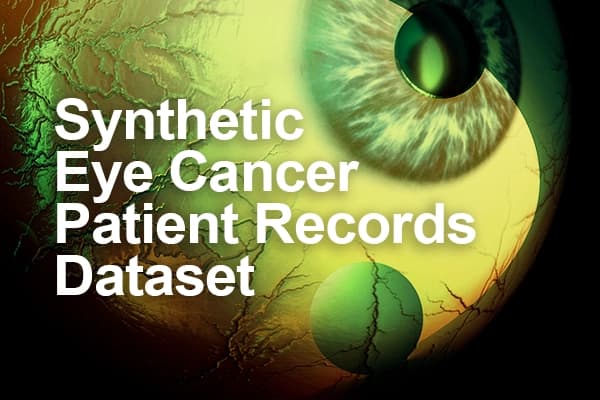Synthetic Eye Cancer Patient Records Dataset
Patient Health Records & Digital Health
Tags and Keywords
Trusted By




"No reviews yet"
£19.99
About
The Synthetic Eye Cancer Patient Records Dataset is a comprehensive, anonymised synthetic dataset created for research and educational purposes. It captures demographic, clinical, genetic, and treatment-related variables to support the study of eye cancer types, progression, treatment efficacy, and survival outcomes.
Dataset Features
- Age: Age of the patient at diagnosis (in years).
- Gender: Biological sex of the patient (Male/Female/Other).
- Cancer_Type: Type of eye cancer diagnosed (e.g., Lymphoma, Melanoma, Other).
- Laterality: Location of the cancer in the eye (Left, Right, Bilateral).
- Date_of_Diagnosis: Date when cancer was diagnosed.
- Stage_at_Diagnosis: Clinical stage at diagnosis (e.g., Stage I, Stage II, Stage III, Stage IV).
- Treatment_Type: Primary treatment modality (e.g., Surgery, Radiation, Chemotherapy).
- Surgery_Status: Whether surgery was performed (True/False).
- Radiation_Therapy: Duration or number of radiation therapy sessions (integer).
- Chemotherapy: Number of chemotherapy cycles administered (integer).
- Outcome_Status: Patient outcome (e.g., In Remission, Active, Deceased).
- Survival_Time_Months: Survival time after diagnosis (months).
- Genetic_Markers: Presence of genetic mutations or markers (e.g., BRAF Mutation), with some missing values.
- Family_History: Family history of cancer (True/False).
- Country: Patient's country of residence.
Distribution

Usage
This dataset can be used for:
- Cancer Research: Investigate relationships among demographics, clinical features, genetics, and treatment outcomes.
- Predictive Modeling: Build models to predict survival time, treatment response, or disease progression.
- Healthcare Analytics: Explore epidemiological trends by cancer type, stage, and geography.
- Educational Use: Provide realistic data for training in oncology data analysis and bioinformatics.
Coverage
The data is fully anonymized and synthetically generated to ensure privacy while preserving clinically relevant variability for academic and data science applications.
License
CC0 (Public Domain)
Who Can Use It
- Oncologists and Medical Researchers: To study eye cancer patterns and outcomes.
- Data Scientists and Bioinformaticians: For developing predictive and survival models.
- Healthcare Educators and Students: As a detailed dataset for hands-on learning in oncology and medical data analysis.
Loading...
